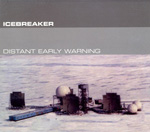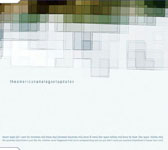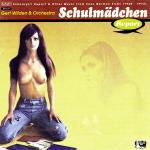Icebreaker, Distant Early Warning (CD, 1999)
 Somewhere in the eastern periferia of Roma there was – is, it looks like – a club so called because of the single palm tree in front of it. (Google seems to show this palm tree, though it’s hard to be sure from above.) La Palma was at that point in time exciting – maybe it still is, I can’t say – and most of the touring American indie bands playing Rome at that point in time played there. Living in Italy was, predictably enough, the high-water mark of my interest in indie rock. It was 2000; things were confused. This would have been at about the same point in time that I tried learning Italian from a facing-page translation of Finnegans Wake. Bad ideas were everywhere.
Somewhere in the eastern periferia of Roma there was – is, it looks like – a club so called because of the single palm tree in front of it. (Google seems to show this palm tree, though it’s hard to be sure from above.) La Palma was at that point in time exciting – maybe it still is, I can’t say – and most of the touring American indie bands playing Rome at that point in time played there. Living in Italy was, predictably enough, the high-water mark of my interest in indie rock. It was 2000; things were confused. This would have been at about the same point in time that I tried learning Italian from a facing-page translation of Finnegans Wake. Bad ideas were everywhere.
I was at La Palma, by my memory, a number of times. Looking at where it is on the Google map, I’m confused by this: how did I get there? I think there was some sort of local train that was not the subway that went there; I have vague memories of a run-down train station in the middle of the night. And I remember getting home by walking – at that point in my life, I didn’t use taxis (this was not a thought-out behavior, it’s just how things were) and the trains didn’t run at three in the morning, so I walked home. Google maps suggests that it would have been just over five miles back to via Plauto, over by the Vatican – was I really walking five hours through the outskirts of Rome at four in the morning, presumably after I’d been drinking? I remember bits of this – passing by the Cimitero Monumentale del Verano, which is enormous and surrounded by little shrines with candles, even in the middle of the night. And Porta Maggiore late at night, with carts selling porchetta and prostitutes – I remember being very tired there, knowing that it was still an enormous distance to anywhere even if I was at the old city limits, and wishing that the subway ran all night. And coming across the Piazza della Repubblica as the sky began to lighten and feeling at home in the city. It seems odd to have been doing that much walking late at night – in terms of distance, it’s roughly akin walking to Central Park from Jackson Heights, which seems somehow inconceivable. Another detail: I wouldn’t have had headphones to keep me entertained while I walked along the highway. That was how I lived then. It’s odd, really.
La Palma was one of the centri sociali, I think, though it was more of hipster than the usual hippy. They’d play Lee Hazlewood & Nancy Sinatra before shows – what did it mean for Italians to be listening to that in 2000? I am out of my depth. Hood was playing there & as my postrock dues were paid up – it was during that brief window where one could listen to Godspeed You Black Emperor and not feel enormously depressed about the world – I went to go see them. I don’t remember very much about Hood – they always sounded very nice on paper, but I never really loved them, though maybe I was listening to the wrong records. Later they fell in with those terrible underground rappers who destroyed everything they touched and it was clear it was time to stop caring. But that was later, this is still 2000, they were on a promising postrock label from Chicago called Aesthetics, and at the time they seemed pleasant. I was, remember, in a susceptible state. It was nice to be in a place where they played Lee Hazlewood & Nancy Sinatra. Is it possible that L’Altra was playing with Hood? Maybe. There might have also been a terrible Italian opening band. I don’t remember anything about Hood.
This CD, though, I’m fairly certain that I bought this CD at that Hood show. I’d never heard Icebreaker (later Icebreaker International), but they were advertised as a side-project of Piano Magic, and they’d shown up in The Wire. (At that point, the magazines that I was reading regularly were The Wire, i-D, and the Times Literary Supplement, make of that what you will. Youth!) But I walked this CD home and opened it up, and the inside flap (all the well-designed CDs of that period were digipacks) explains that this is a record about NATO’s distant early warning system, which is almost a good concept for an album. (Their next album, which I bought when I arrived in New York, firmed up the conceptualism: entitled Trein Maersk, it was ostensibly recorded on a container ship of that name sailing around the world; straight-faced soundbites paid tribute to the glory of free trade, and the band had decided that it was okay to like techno, which improved things tremendously. That this was an enormous – and reasonably good, considering – joke was lost on most of the critics.) The tracks have names that fit in with the concept (“Co-prosperity Sphere,” “The Arctic Night,” “Reconnaissance Flight”) though all are instrumentals and one suspects that the titles were added after the fact.
Concept aside, the first track of this 49-minute CD (“Melody for NATO”) is far and away the best. This had appeared on a split 7” with Piano Magic; had I been more discerning and in a place where Piano Magic 7”s could have been procured, I could have skipped this CD entirely. Believing at that juncture in time that artists’ intentions should be honored and CDs should be listened all the way through, I listened to this CD all the way through many times; I remember nothing about any of the other tracks except that they’re mostly warm drones; looped synthesizers, a few Arctic-feeling samples, maybe, drums on a few tracks. They’re not at all unpleasant, but they’re nowhere as nice as the first one, which feels like a slow pop song without words. It’s a fine CD to put on when you’re going to bed – the first song is nice and then you’re asleep & things are happily going on in the world without you.




